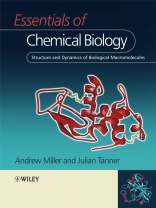‚This excellent work fills the need for an upper-level graduate course resource that examines the latest biochemical, biophysical, and molecular biological methods for analyzing the structures and physical properties of biomolecules… This reviewer showed [the book] to several of his senior graduate students, and they unanimously gave the book rave reviews. Summing Up: Highly recommended…‘
CHOICE
Chemical biology is a rapidly developing branch of chemistry, which sets out to understand the way biology works at the molecular level. Fundamental to chemical biology is a detailed understanding of the syntheses, structures and behaviours of biological macromolecules and macromolecular lipid assemblies that together represent the primary constituents of all cells and all organisms. The subject area of chemical biology bridges many different disciplines and is fast becoming an integral part of academic and commercial research.
This textbook is designed specifically as a key teaching resource for chemical biology that is intended to build on foundations lain down by introductory physical and organic chemistry courses. This book is an invaluable text for advanced undergraduates taking biological, bioorganic, organic and structural chemistry courses. It is also of interest to biochemists and molecular biologists, as well as professionals within the medical and pharmaceutical industry.
Key Features:
* A comprehensive introduction to this dynamic area of chemistry, which will equip chemists for the task of understanding and studying the underlying principles behind the functioning of biological macro molecules, macromolecular lipid assemblies and cells.
* Covers many basic concepts and ideas associated with the study of the interface between chemistry and biology.
* Includes pedagogical features such as: key examples, glossary of equations, further reading and links to websites.
* Clearly written and richly illustrated in full colour.
CHOICE
Chemical biology is a rapidly developing branch of chemistry, which sets out to understand the way biology works at the molecular level. Fundamental to chemical biology is a detailed understanding of the syntheses, structures and behaviours of biological macromolecules and macromolecular lipid assemblies that together represent the primary constituents of all cells and all organisms. The subject area of chemical biology bridges many different disciplines and is fast becoming an integral part of academic and commercial research.
This textbook is designed specifically as a key teaching resource for chemical biology that is intended to build on foundations lain down by introductory physical and organic chemistry courses. This book is an invaluable text for advanced undergraduates taking biological, bioorganic, organic and structural chemistry courses. It is also of interest to biochemists and molecular biologists, as well as professionals within the medical and pharmaceutical industry.
Key Features:
* A comprehensive introduction to this dynamic area of chemistry, which will equip chemists for the task of understanding and studying the underlying principles behind the functioning of biological macro molecules, macromolecular lipid assemblies and cells.
* Covers many basic concepts and ideas associated with the study of the interface between chemistry and biology.
* Includes pedagogical features such as: key examples, glossary of equations, further reading and links to websites.
* Clearly written and richly illustrated in full colour.
Inhaltsverzeichnis
Preface.Glossary of physical terms.
1. The structures of biological macromolecules and lipid
assemblies.
1.1. General introduction.
1.2. Protein structure.
1.3. Carbohydrate structure.
1.4. Nucleic acid structure.
1.5. Macromolecular lipid assemblies.
1.6. Structural forces in biological macromolecules.
2. Chemical and biological synthesis.
2.1. Introduction to synthesis in chemical biology.
2.2. Chemical synthesis of peptides and proteins.
2.3. Chemical synthesis of nucleic acids.
2.4. Chemical synthesis of oligosaccharides.
2.5. Chemical synthesis of lipids.
2.6. Biological synthesis of biological macromolecules.
2.7. Directed biological synthesis of proteins.
2.8. Biological syntheses of nucleic acids, oligosaccharides and
lipids.
3. Molecular biology as a toolset for chemical
biology.
3.1. Key concepts in molecular biology.
3.2. Tools and techniques in molecular biology.
3.3. Cloning and identification of genes in DNA.
3.4. Integrating cloning and expression.
3.5. Site-directed mutagenesis
4. Electronic and vibrational spectroscopy.
4.1. Electronic and vibrational spectroscopy in chemical
biology.
4.2. UV-visible spectroscopy.
4.3. Circular dichroism spectroscopy.
4.4. Vibrational spectroscopy.
4.5. Fluorescence spectroscopy.
4.6. Probing metal centres by absorption spectroscopy.
5. Magnetic resonance.
5.1. Magnetic resonance in chemical biology.
5.2. Key principles of NMR.
5.3. Two-dimensional NMR.
5.4. Multi-dimensional NMR.
5.5. Biological macromolecule structural information.
5.6. EPR spectroscopy; key principles.
6. Diffraction and microscopy.
6.1. Diffraction and microscopy in chemical biology.
6.2. Key principles of X-ray diffraction.
6.3. Structural information from X-ray diffraction.
6.4. Neutron diffraction.
6.5. Key principles of electron microscopy.
6.6. Key principles of scanning probe microscopy.
7. Molecular recognition and binding.
7.1. Molecular recognition and binding in chemical biology.
7.2. Theoretical models of binding.
7.3. Analysing molecular recognition and binding.
7.4. Biological molecular recognition studies.
8. Kinetics and catalysis.
8.1. Catalysis in chemical biology.
8.2. Steady state kinetic schemes.
8.3. Pre-steady-state kinetics.
8.4. Theories of biocatalysis.
8.5. Electron transfer.
9. Mass spectrometry and proteomics.
9.1. Mass spectrometry in chemical biology.
9.2. Key principles in mass spectrometry.
9.3. Structural analysis of biological macromolecules and lipids
by mass spectrometry.
9.4. The challenge of proteomics.
9.5. Genomics – assigning function to genes and proteins.
10. Molecular selection and evolution.
10.1. Chemical biology and the origins of life.
10.2. Molecular breeding; natural selection acting on
self-organisation.
10.3. Directed evolution of protein function.
10.4. Directed evolution of nucleic acids.
10.5. Catalytic antibodies.
References.
Index.
Über den Autor
Andrew Miller Imperial College Genetic Therapies Centre, Department of Chemistry, Imperial College London, UKJulian Tanner Department of Biochemistry, The University of Hong Kong
Sprache Englisch ● Format EPUB ● Seiten 592 ● ISBN 9781118687833 ● Dateigröße 17.9 MB ● Verlag John Wiley & Sons ● Erscheinungsjahr 2013 ● Ausgabe 1 ● herunterladbar 24 Monate ● Währung EUR ● ID 2680467 ● Kopierschutz Adobe DRM
erfordert DRM-fähige Lesetechnologie












